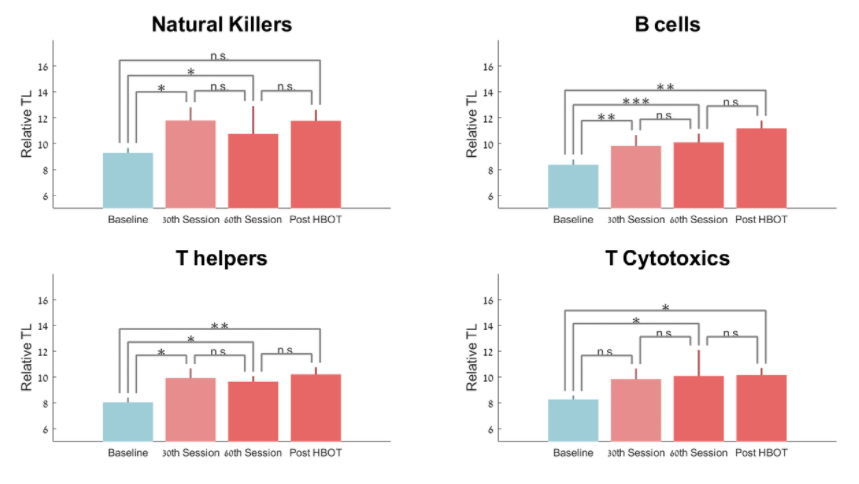Two major biological events associated to the onset of medical conditions that proceed upon aging are telomere shortening and the accumulation of senescent cells in the body. Telomeres encompass the regions at the ends of chromosomes and exhibit protective properties. Senescent cells are old cells that can no longer undergo cell division, and they ultimately become malfunctional. Both biological events are linked to higher risks of developing age-related diseases such as cancer and cardiovascular diseases.
The lengths of telomeres and concentration of senescent cells among human blood immune cells were evaluated in a study conducted by Efrati and colleagues from Sharmir Medical Center and Tel Aviv University in Israel. The goal of the experiment was to evaluate how hyperbaric oxygen therapy, exposure to 100% oxygen at a high level of ambient pressure, affected these two variables. Results showed a 20-38% range of growth for telomeres in different immune cell types. In addition, they saw an 11-37% reduction in senescent cell population for different cell types.


(Hachmo et al., 2020 | Aging [Albany NY]) White blood cell types show increased telomere length and decreased senescence in humans exposed to hyperbaric oxygen therapy. Top four graphs: All types of white blood cells measured had telomere length (TL) increase from repeated hyperbaric oxygen therapy sessions. Bottom graph: Senescent cell percentages decreased in T-helper white blood cells after 30 and 60 hyperbaric oxygen therapy sessions along with two to three weeks after the 60th session (Post HBOT).
“Today telomere shortening is considered the ‘Holy Grail’ of the biology of aging,” said Professor Efrati in a press release. “Researchers around the world are trying to develop pharmacological and environmental interventions that enable telomere elongation. Our [hyperbaric oxygen therapy] protocol was able to achieve this, providing that the aging process can in fact be reversed at the basic cellular-molecular level.”
Increased stem cell proliferation, induction of neurogenesis, and production of new mitochondria become possible from utilizing hyperbaric oxygen therapy. However, its effect on telomere length and senescent cell concentration had not been previously investigated.
Enfrati and colleagues conducted a 90-day trial in which 35 healthy subjects aged 64 and over underwent 60 hyperbaric oxygen therapy sessions. Blood samples from the patients were taken at the following times: before the trial, during the trial, the end of the trial, and 1-2 weeks after the trial ended. With these samples, the Israeli research team was able to utilize the observed telomere lengths along with cellular markers of senescence to dictate the percentage of present senescent cells as well as conclude whether there was growth in telomeres.
“Until now, interventions such as lifestyle modifications and intense exercise were shown to have some inhibiting effect on telomere shortening,” stated Dr. Hadanny, an author of the study, in the press release. “But in our study, only three months of [hyperbaric oxygen therapy] were able to elongate telomeres at rates far beyond any currently available interventions or lifestyle modifications. With this pioneering study, we have opened a door for further research on the cellular impact of [hyperbaric oxygen therapy] and its potential for reversing the aging process.”
A few limitations can be seen in this study. The first being the lack of a control group to compare results to the experimental group. Having a group of participants that lacked hyperbaric oxygen therapy would provide more validity to this study. In addition, only 35 healthy, aging subjects participated in the study, and this is considered to be a small sample size for the experiment, which is not ideal. The effects of hyperbaric oxygen therapy combined with other interventions on telomere length and senescent cell clearance has yet to be elucidated and require future studies to assess whether akin effects are observed in other tissues with this therapy.